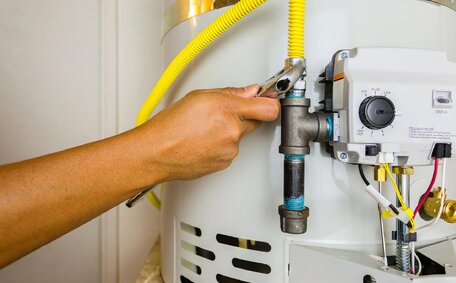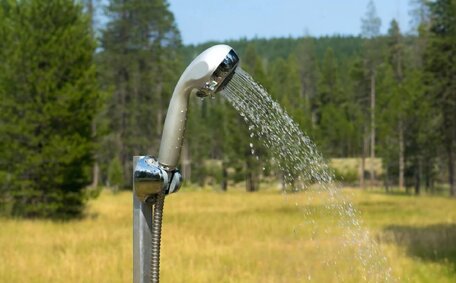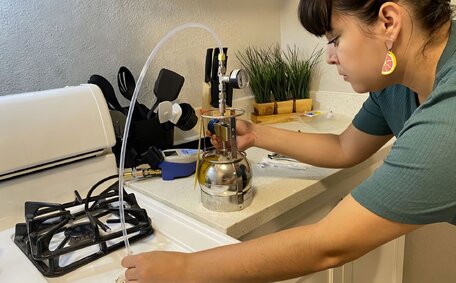Locating the Drain Valve on Your Hot Water System
Identifying the drain valve is essential for draining and general maintenance of hot water systems.
Electric Water Heaters
On an electric water heater, the drain valve is typically located at the bottom of the hot water tank. The drain can be made of plastic or brass, often compatible with a standard garden hose fitting.
Gas Water Heaters
On a gas water heater, find the pilot light and heater drain at the unit’s base. This valve typically resembles a spigot and is easy to identify.
Heat Pump Water Heaters
Heat pump water heaters may have more than one drain valve, typically found at both the bottom and top sides of the unit; refer to the manual for specifics.
Storage Tanks
If you have a separate hot water tank, look along the side or base. You may need to trace the cold water supply line back to find the drain valve.
Consult your water heater’s manual or the manufacturer if the drain valve eludes you, as positions can change across models. Calling a professional plumber can also help identify the valve if problems persist.
When to Open the Drain Valve
There are essential times to open your hot water tank’s drain valve:
Routine Maintenance
Regular maintenance, including draining and flushing the tank every 6-12 months, prevents sediment buildup, ensuring efficient operation of your hot water system.
Water Heater Repairs
To replace internal components, ensure you open the drain valve to empty the tank safely after checking the hot water flow.
No Hot Water Issues
Draining the tank when there’s no hot water aids in identifying whether the issue lies with sediment buildup or a more grave problem such as a malfunctioning heating element or thermostat.
For safety, always shut off the power and gas at the circuit breaker before manipulating any drain valves. Refer to your water heater’s manual for complete instructions specific to your unit.
Troubleshooting Common Drain Valve Issues
Clogged Drain Valve
A clogged valve hampers proper water drainage from your electric water heater. Follow these steps to fix it:
- Turn off the power and secure the gas or electric connections to your water heater.
- Disconnect any hoses or pipes from the drain valve of your gas electric water unit.
- Use a wire coat hanger to loosen and dislodge debris from your gas or electric water heater.
- Clear the system by flushing it with clean water, removing any clogs.
- Reconnect and test valve drainage.
Leaking Drain Valve
Leaking drain valves often point to worn washers or valve seats. Follow these steps for repair:
- Disconnect the water supply and power.
- Drain the tank completely.
- Disassemble the valve and inspect washers and seats for cracks.
- Replace any damaged parts.
- Reassemble and test for leaks.
Malfunctioning Mechanism
If the drain valve handle spins freely without opening, the interior mechanism may be damaged. This requires replacing the entire valve. Call us for professional plumbing assistance.
Clogs Preventing Proper Drainage
Identifying Drain Valve Clogs
A clogged drain valve may impede the water’s exit from your hot water heater, causing it to drain too slowly. Signs include:
- Cloudy water draining out
- Water flowing slowly or not at all
- Gurgling sounds from the valve
- Water overflowing from the valve opening
Removing Drain Valve Clogs
To remove clogs:
- Turn off power supplies, and for gas water heaters, make sure the pilot light is off for safety.
- Position a bucket underneath the valve to collect water.
- Disassemble any pipes or hoses from the valve.
- Utilise a wire coat hanger or valve cleaning brush to dislodge debris.
- Flush clean water through to clear out clogs.
- Reassemble and test water drainage.
Annual system flushing can avert future clogs. For persistent problems, it’s best to consult a professional plumber.
Leaks Around the Valve
Water escaping around the edges of your system’s drain valve could signal a loose valve, compromised washers, or a defective valve seat.
Signs of Leaks
Check for these signs of leaks:
- Water pooling under the water heater
- Water leaking from the valve and pipe connections
- Rust streaks on the valve or tank
Fixing Leak Issues
To stop leaks:
- Turn off the gas/power supply and water lines.
- Place a bucket under the valve.
- Disassemble pipes and inspect washers and valve seats.
- Replace any damaged gaskets or parts.
- Reassemble and turn water supply back on to check for leaks.
Should leaks persist, don’t hesitate to call us as the entire assembly may need replacement.
Malfunctioning Valve Mechanism
If your drain valve handle spins freely without opening or closing the valve, the interior mechanism may be damaged or worn out.
Signs of a Malfunction
Common signs include:
- The handle spins but water doesn’t drain
- The valve seems stuck open/closed
- Water continues leaking even when turned off
- Corrosion visible around the valve fittings
Fixing Issues
You may be able to take the valve apart and replace specific components like washers. However, if the central rod or stem is damaged, the entire assembly will likely need professional replacement.
If malfunctions continue despite simple home repairs, it’s time to call a licenced plumber to inspect and possibly replace the faulty valve mechanism.
Annual drain valve flushing can help prevent mineral deposits and corrosion that damage mechanisms over time.
Preventing and Fixing Leaks from the Drain Valve
Preventing Drain Valve Leaks
You can prevent leaks from the drain valve by:
- Inspecting the valve and pipe connections regularly for moisture or drips.
- Replacing worn washers and gaskets.
- Cleaning the valve opening and seating areas of mineral deposits.
- Operating the valve once a year to prevent it from seizing up.
Fixing Drain Valve Leaks
To fix a leaking drain valve:
- Turn off the power and gas supply.
- Drain the tank completely.
- Disassemble the valve and inspect for cracks or damage.
- Replace old washers, gaskets and valve seats as needed.
- Reassemble and check for leaks.
- If leaks persist, replace the entire valve.
Be sure to call a professional plumber for assistance if you have any doubts or issues while repairing your drain valve.
Maintaining Proper Water Pressure
Importance of Water Pressure
Optimal water pressure is crucial for the efficient functioning of water systems. Excessively high pressure can hasten component wear, while low pressure may lead to flow problems.
Checking Water Pressure
Check the incoming water pressure at a hose bib using a pressure gauge; an ideal range is 40-80 psi. Consistently high or low readings indicate a problem.
If the pressure is adequate but the hot water output is weak, consider increasing the thermostat setting, which may be too low. Adjust it higher incrementally, testing water temp as you go until it reaches 120°F.
When to Call a Professional
For ongoing water pressure problems in your electric hot water system despite adjustments, significant drops in pressure, or no hot water issues, contact a licenced plumber to inspect your entire system.
Adjusting Water Temperature
Checking Current Water Temperature
Before making any adjustments, check your current hot water temperature using a thermometer:
- When water is heated, turn on the hot tap and let it run for a minute.
- Place a cooking thermometer under the stream to measure the temperature.
- Compare to your water heater’s manual for the factory setting (usually 120-140°F).
Increasing the Temperature
If your current temp is too low, locate the thermostat on the tank and turn it higher incrementally, testing as you go until desired temp is reached.
Decreasing the Temperature
For temp that’s too hot, turn the thermostat down incrementally and retest. Lowering risk of scalding is crucial.
If you cannot get the temperature within normal range despite adjustments, contact a licenced plumber to inspect your thermostat and heating elements.
When to Seek Professional Help
Homeowners should recognise when a drain valve problem exceeds their repair skills. Seeking help from a professional plumber to replace your parts should be considered if:
- The drain valve is stuck closed and you cannot get it to open at all
- There are leaks persisting after replacing washers and gaskets
- The valve mechanism is broken and the handle spins freely without opening/closing
- There are signs of corrosion or mineral buildup you cannot remove
- Drainage flow seems obstructed by something stuck inside the valve
- Issues keep recurring shortly after your repairs
Untrained attempts at complex repairs can pose safety risks, potentially leading to scalding or water damage. For persistent drain valve problems, trust the licenced professionals at Blakehurst Plumbing. Our experienced plumbers can quickly diagnose issues and get your hot water system working safely again.
Importance of Maintenance to Extend System Lifespan
Routine Maintenance Prolongs Lifespan
Routine maintenance is key to extending the service life of your hot water system. Industry experts recommend servicing your unit before essential components stop working, ensuring it operates safely and efficiently.
Maintenance Can Prevent Issues
Regular maintenance helps prevent problems before they occur. Draining sediment, replacing anodes, checking connections for leaks can avoid more serious issues down the line like element failure or corrosion damage.
Steps Included in Standard Maintenance
A professional plumber’s annual service typically encompasses:
- Draining and flushing the tank
- Inspecting anodes and replacing them before they break down if worn
- Testing water temperature and pressure
- Checking fittings, pipes and valves for leaks
- Clearing out debris around the unit
Maintenance keeps your water heater in its best possible working order.
We’re Here to Help
For professional maintenance or repairs, the licenced plumbers at Blakehurst Plumbing are ready to assist. Contact us at 1300 349 338 to schedule annual servicing.






